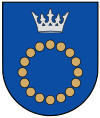Palanga
| Palanga | ||
|---|---|---|
| City municipality | ||

The Tiškevičiai Palace houses the Amber Museum
|
||
|
||
| Nickname(s): Vasaros sostinė (Summer Capital) | ||
| Location of Palanga | ||
| Coordinates: 55°55′N 21°4′E / 55.917°N 21.067°ECoordinates: 55°55′N 21°4′E / 55.917°N 21.067°E | ||
| Country |
|
|
| Ethnographic region | Samogitia | |
| County |
|
|
| Municipality | Palanga city municipality | |
| First mentioned | 1161 | |
| Granted city rights | 1791 | |
| Elderships | Šventoji eldership | |
| Area | ||
| • Total | 79 km2 (31 sq mi) | |
| Population (2008) | ||
| • Total | 17,600 | |
| • Density | 223/km2 (580/sq mi) | |
| Time zone | EET (UTC+2) | |
| • Summer (DST) | EEST (UTC+3) | |
| Website | http://www.palanga.lt | |
Palanga (![]() pronunciation ) is a seaside resort town in western Lithuania, on the shore of the Baltic Sea. It is the busiest summer resort in Lithuania and has beaches of sand (18 km long and up to 300 m wide) and sand dunes. Officially Palanga has the status of a city municipality and includes Šventoji, Nemirseta, Būtingė and other settlements, which are considered as part of the city of Palanga.
pronunciation ) is a seaside resort town in western Lithuania, on the shore of the Baltic Sea. It is the busiest summer resort in Lithuania and has beaches of sand (18 km long and up to 300 m wide) and sand dunes. Officially Palanga has the status of a city municipality and includes Šventoji, Nemirseta, Būtingė and other settlements, which are considered as part of the city of Palanga.
According to a legend, there was a pagan shrine at the foot of a hill in Palanga where a beautiful priestess named Birutė used to tend the ceremonial fires. Having heard of Birutė's beauty, Kęstutis, the Grand Duke of Lithuania, came to make her his wife. It is written in the Lithuanian Bychowiec Chronicle that Birutė "did not consent, and answered that she had promised the gods to remain a virgin as long as she lived. Kęstutis then resorted to take her by force, and with great pomp brought her back to his capital, Trakai, where he invited his kinsmen and celebrated with a lavish wedding..." Kęstutis was later murdered and Birutė returned to Palanga and resumed serving at the shrine until her death. The legend claimed that she was buried in the hill which is now named after her.
Not far from Šventoji, archaeologists discovered an encampment which indicates that the area was inhabited some 5,000 years ago. Between the 10th and 13th centuries Palanga had been one of the main settlements of Mēguva Land, inhabited by the Curonians. Situated upon the trail of the ancient Amber Road, it became a center of trade and crafts.
...
Wikipedia


